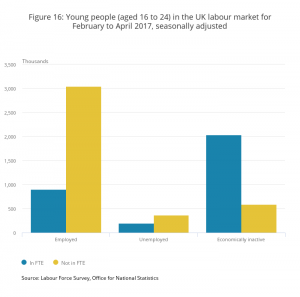The latest ONS data shows the employment rate at 74.8%, at its highest since comparable records began. The data available cover the period from February 2017 – April 2017.
The figures show that the number of people in work increased, the number of those unemployed fell and the number of people aged 16 – 24 not seeking or available to work (economically inactive) also fell.
We take a look at the headlines and the youth unemployment figures in more detail.
The Headlines
- There were 31.95 million people in work, 109,000 more than for November 2016 to January 2017 and 372,000 more than for a year earlier.
- The employment rate (the proportion of people aged from 16 to 64 who were in work) was 74.8%, the joint highest since comparable records began in 1971.
- There were 1.53 million unemployed people (people not in work but seeking and available to work), 50,000 fewer than for November 2016 to January 2017 and 145,000 fewer than for a year earlier.
- The unemployment rate (the proportion of those in work plus those unemployed, that were unemployed) was 4.6%, down from 5.0% for a year earlier and the lowest since 1975.
- Latest estimates show that average weekly earnings for employees in Great Britain in real terms (that is, adjusted for price inflation) fell by 0.4% including bonuses, and fell by 0.6% excluding bonuses, compared with a year earlier.
Youth Employment figures
 Within this data set young people are defined as those aged 16 – 24. Young people in full-time education are included in the employment estimates if they have a part-time job and are included in the unemployment estimates if they are seeking part-time work.
Within this data set young people are defined as those aged 16 – 24. Young people in full-time education are included in the employment estimates if they have a part-time job and are included in the unemployment estimates if they are seeking part-time work.
For February to April 2017:
- 3.94 million people in work (including 900,000 full-time students with part-time jobs)
- 564,000 unemployed people (including 198,000 full-time students looking for part-time work)
- 2.62 million economically inactive people, most of whom (2.04 million) were full-time students
The unemployment rate for 16-24 year olds for this period was 12.5%, the same as last month, lower than a year earlier (13.6%). The unemployment rate for those aged from 16 to 24 has been consistently higher than that for older age groups.
Since comparable records began in 1992:
- the lowest youth unemployment rate was 11.6% for March to May 2001
- the highest youth unemployment rate was 22.5% for late 2011
Next Steps:
Join Youth Employment UK as a Community Member and work with us to help tackle Youth Unemployment
Read our #CareersCampaign and see our recommendations for a new careers strategy
Read our APPG for Youth Employment report into youth employment data here
Read more of our articles and best practise support here







